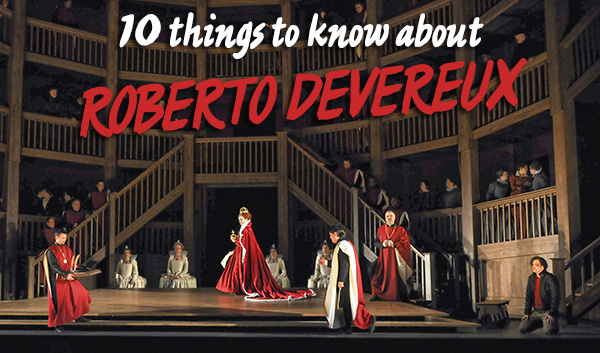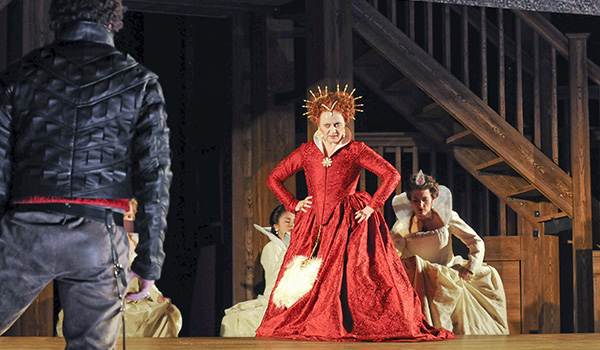-
10 Things to Know About Gaetano Donizetti’s Roberto Devereux
By Danielle D'OrnellasPosted in Roberto DevereuxBy Nikita Gourski, Development Communications Officer

This April, Donizetti's 'Tudor Trilogy' comes to an end with the COC premiere of Roberto Devereux. Here are ten key things you may want to know before you head to your seat!
1) Royal Intrigues
In the opera, a cloud of suspicion hangs over the Queen’s beloved Roberto Devereux, who has been accused of treason by members of Parliament. Elisabetta (Elizabeth I) doesn’t believe the charges, but she soon learns that Devereux might have betrayed her in another, more personal way, by falling in love with Sara, the Duchess of Nottingham. As Devereux’s life hangs in the balance, the Queen must navigate between her obligations as monarch and her all-too-human emotions as a woman in love.2) A prima donna role
Roberto Devereux (1837) is the final instalment in Gaetano Donizetti’s “Tudor Trilogy” which also includes Anna Bolena (1830) and Maria Stuarda (1835). Central to each of these operas is a soprano role which stretches the singer to the limits of her technical and dramatic capabilities. It’s generally agreed that the role of Elisabetta in Roberto Devereux represents the summit of these prima donna (principal female) roles with regards to difficulty.3) The best of bel canto
Bel canto (literally, “beautiful singing”) is a term usually applied to early 19th-century Italian operas with a highly exhibitionist style of singing. Though some bel canto operas seem to privilege vocal showmanship at the expense of storytelling and characterization, in Roberto Devereux the brilliant singing stems directly from emotions related to the text and also from the influence of the words themselves – the colour of the consonants and vowels of the Italian language. This requires a huge investment of dramatic as well as vocal energy from the singer – quite the opposite of the stereotypical view of the prettily chirping bel canto “nightingale.” Hear the music in our listening guide.
Sondra Radvanovsky as Anna Bolena in a photo for the Lyric Opera of Chicago.4) The Return of Sondra Radvanovsky
One of the world’s best sopranos, Sondra Radvanovsky returns to the COC after her stunning debut with the company (Aida, 2010), to sing the role of Elisabetta for the very first time in her career. She has also been engaged by the Met to perform the role.Ms Radvanovsky “sings with unflinching honesty and uncommon intensity…” The New York Times
5) Triple Crown
With her role debut at the COC, Sondra Radvanovsky will have performed all three Donizetti queens, a significant achievement. Famously, the great American soprano Beverly Sills, who also accomplished the triple crown in the 1970s, reputedly said the difficulty of singing all three roles may have shortened her career by at least four years.6) COC Premiere
Roberto Devereux has never been seen at the Canadian Opera Company, and this premiere offers Toronto a unique opportunity to experience this powerful drama of show-stopping vocal fireworks and intense emotions.
7) Elizabethan-inspired production
This production from Dallas Opera, directed by Stephen Lawless, takes its inspiration from the powerful personality of Queen Elizabeth I, and adopts a theatrical style that was popular during her reign. Within this historical framework, the creative team found inspiration in one of the most famous Elizabethan playhouses, Shakespeare’s Globe Theatre in London.8) Staging the Queen’s Biography
The production makes a number of references to significant moments in Queen Elizabeth’s life: three large display cases appear at the top of the overture, each containing an actor to represent an aspect of Elizabeth’s difficult childhood, including Henry VIII (Elizabeth’s father), Anne Boleyn (Elizabeth’s mother), as well as a young Elizabeth. At the end of the overture, models of warships sail onto the front of the stage, depicting the greatest naval victory of Elizabeth’s reign: repelling the vast Spanish Armada.
9) Elizabethan costumes
Designer Ingeborg Bernerth’s costumes are generally period-specific and reflect the era in which Roberto Devereux has been set, though some pieces have been modernized (the men’s costumes in particular). Queen Elizabeth was the first monarch to take an interest in fashion and its effect on status and societal perceptions. Her rule was a prosperous one and fashions were correspondingly luxurious and elaborate, often embellished and exaggerated.10) What to Listen For
Get the musical highlights with our listening guide here. For a quick preview, visit our listening guide.Photo: (top) (l – r) Scott Quinn as Lord Cecil, Hasmik Papian as Elisabetta, Andrew Oakden as Sir Gualtiero Raleigh, David Kempster as Duke of Nottingham and Stephen Costello as Roberto Devereux in the Dallas Opera production of Roberto Devereux, 2009. Photo by Karen Almond; (middle) Sondra Radvanovsky as Anna Bolena in a promotional photo for the Chicago Lyric Opera. Photo by Cade Martin; (bottom) Stephen Costello as Roberto Devereux and Hasmik Papian as Elisabetta in the Dallas Opera production of Roberto Devereux, 2009. Photo by Karen Almond.
